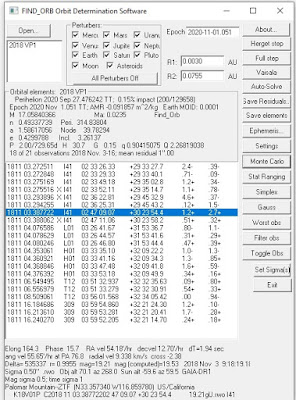2018 VP1 Information Sheet-- "1 in 240" Odds of a Fireball on 2020-11-02 or ."99.59% chance the asteroid will MISS the Earth"
Throughout the year, very small rocks strick the Earth's atmosphere and creating spectacular fireballs. Most of these rocks travel through space unknown to habitats of Earth until they strick the atmosphere. If we are lucky, the fireball will be seen and reported. If we are really lucky, the fireballs will be capture on film. The most vast majority of fireballs are of no danger what so ever. Most fireballs are like rainbows in that they are cool. Four times in the past, these rocks travel through the field of vision of an asteroid observer before impact. Observation was taken. The rocks were given designations, like 2014
AA( i.e., the first discovery of the first half of January in 2014), and the rocks "became" asteroids. These four asteroids were on the safe side when it comes to size.
In the first half of November 2018, an asteroid was discovered and give the designation 2018 VP1. This asteroid is very small[1.8 m - 3.9 m ( 5.90551 to 12.79528 feet) ]. This asteroid was only observed 21 times over 13 days.
In orbit determination, one calculation what orbit will place the object in the sky where it was seen. If one knows an object's orbit, it knows where it is going and where it will be in the sky. All observations are "imperfect," so there will be many similar orbits. If one were to create virtual asteroids for each of the similar orbits and did a simulation, one would see over time. The virtual asteroids move apart from each other to create an uncertainty region. The real asteroid is somewhere within the uncertainty region. When doing the simulation, if any of the virtual asteroids impact the Earth, they become virtual impactors, and there is 'Non-Zero' probability of the real asteroid hitting the Earth. By calculating the percentage of virtual impactors to virtual asteroids, one can calculate the risk of impact.
There is a very low-risk impact 2018 VP1 will on 2020-11-02. However, it must be restarted this asteroid is very small[1.8 m - 3.9 m ( 5.90551 to 12.79528 feet) ].
We have a fireball this size about two times a year.

|
| Find_orb computing Monte Carlo variant orbits for the NEO 2018 VP1. One can use Monte Carlo method to create virtual asteroids. By using orbits of the virtual asteroids one can can see where the "real" asteroid could go. If any of virtual asteroids impact the Earth they become known as virtual impactors and the is 'Non-Zero' probability of the real asteroid hitting the Earth |
Background
(as of 2020-06-13 )
- Object: 2018 VP1
- Orbit Type: NEO Apollo
- Approximate Diameter: 1.8 m - 3.9 m ( 5.90551 to 12.79528 feet) (Absolute Magnitude: H=30.9)
- On the Sentry Risk Table: YES
- Impact Probability(2020-11-02.05) = 4.1e-3
- 0.41% chance of Earth impact
- 1 in 240 odds of impact
- 99.59% chance the asteroid will miss the Earth
- for more information read Understanding Risk Pages by Jon Giorgini
- On the NEODyS CLOMON2 risk page: YES
- (2020-11-02.051) 5.16e-3
- 0.516%
- 1 in 194
- 99.484% chance the asteroid will miss the Earth
- Possible Earth Impact Effects Program of 2018 VP1
- Listed on The Near-Earth Object Human Space Flight Accessible Targets Study (NHATS):NO
- Listed on the Goldstone Asteroid Radar Schedule:NO
- Listed on the Arecibo Asteroid Radar Schedule:NO
- Radar Observations:
- Discovery observation was made: 2018 11 03.27284202 5 (By Palomar Mountain--ZTF (MPC Code I41)[ First precovery observation was 2018 11 03.27249502]
- Last Observation(publish) was made: 2018 11 16.24026503 (By Cerro Paranal (MPC Code 309))
- Data-Arc Span (publish): 13 days ( yr)
- Number of Optical Observations(published): 21
- Oppositions: 1
- Number of Observatories Reporting (Published) Observations :5
- Observatories Reporting (Published) Observations(MPC Code):
- (309) Cerro Paranal, Chile.
- (H01) Magdalena Ridge Observatory, Socorro, US/New
- (I41) Palomar Mountain--ZTF, US/California.
- (L01) Višnjan Observatory, Tičan, Croatia.
- (T12) Mauna Kea-UH/Tholen NEO Follow-Up (2.24-m)
- Perihelion Distance: 0.9051326626577225 (AU)
- Aphelion Distance: 2.270308947523921 (AU)
- Earth MOID: 5.54556E-5 (AU), 0.022 (LD), 1.30069951121949 (Earth Radii), (Miles), or 8,296.04 5,154.92 (KM)
- Close-Approach to Earth: Will pass the Earth on 2020-Nov-02 11:33 at a Nominal Distance(Best Fit) of 0.00280167254552464 (AU), 1.09 (LD), 65.71 (Earth Radii), 260,431.733 (Miles), or
419,124.247(KM). "IF" the Earth was the Size of a Basketball flyby
would be 25.53 feet ( 7.78 meters) away
- Close-Approach to Earth Uncertainty:
- Distance (Maximum Distance (au) - Minimum Distance (au)): 0.0256085074009903 - 3.90766585857012e-05 = 0.02556943074(AU) 9.951(LD) or 3,825,132.39 KM( 2,376,827.07 Miles)
- Time Uncertainty: (minutes) 4750.56847240545 ( 3 Days 7 Hours 11
Minutes)
- Object velocity relative to Earth at close-approach [V-relative] (KM/S): 9.71114662839966
- Object velocity relative to a massless Earth at close-approach[V-infinity](KM/S):9.61271582257126
- Visibility:
Note: this was edited to add links missing data formatting, typos, replace, the image of
Find_orb computing, fixing bad links .







